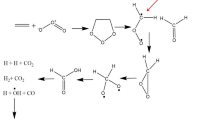Conclusions
-
1.
On reaction of organometallic radicals M (C5H5)(CO)X (Fe, Mo, W) with ortho-quinones, the free radicals of the phenoxyl type formed initially as a result of cleavage of the CO groups are converted to metal-centered free radicals.
-
2.
For molybdenum and tungsten, we found two types of complexes containing one and two ortho-quinone liganda.
-
3.
The state of the Mo and W atoms is characterized by 4d1 and 5d1 electronic configurations with localization of the unpaired electron in the dxy orbital.
-
4.
In order to describe the state of the Fe atom, we assume the configuration 3d7 with coordination by the unreduced form of the ortho-quinone.
Similar content being viewed by others
Literature cited
M. Wrighton, Chem. Rev.,74, 401 (1974).
B. L. Tumanskii, K. Sarbasov, S. P. Solodovnikov, N. N. Bubnov, A. I. Prokof'ev, and M. I. Kabachnik, Dokl. Akad. Nauk SSSR,259, 611 (1981).
K. Sarbasov, B. L. Tumanskii, S. P. Solodovnikov, N. N. Bubnov, A. I. Prokof'ev, and M. I. Kabachnik, Izv. Akad. Nauk SSSR, Ser. Khim., 550 (1982).
R. M. Buchanan, S. L. Kessel, H. H. Downs, C. G. Pierpont, and D. N. Hendrickson, J. Am. Chem. Soc.,100, 7894 (1973).
R. M. Buchanan and C. G. Pierpont, Inorg. Chem.,18, 1616 (1979).
S. P. Solodovnikov, A. N. Nesmeyanov, N. A. Volkenau, N. A. Sinitsyna, and L. S. Kotova, J. Organomet. Chem.,20, 169 (1969).
A. Abragam and B. Bleaney, Electron Paramagnetic Resonance of Transition Ions, Oxford University Press, New York (1970).
I. N. Marov and N. A. Kostromina, EPR and NMR in the Chemistry of Coordination Compounds [in Russian], Nauka, Moscow (1979), pp. 46–87, 115–151.
H. Kuska and M. Rogers, EPR of Transition Metal Complexes [Russian translation], Mir, Moscow (1970), pp. 23–24.
Author information
Authors and Affiliations
Additional information
Translated from Izvestiya Akademii Nauk SSSR, Seriya Khimicheskaya, No. 7, pp. 1509–1516, July, 1982.
Rights and permissions
About this article
Cite this article
Sarbasov, K., Solodovnikov, S.P., Tumanskii, B.L. et al. EPR spectra of free radicals and complexes formed on photolysis of some dimers of carbonylmetallocenes in the presence of ortho-quinones. Russ Chem Bull 31, 1345–1351 (1982). https://doi.org/10.1007/BF00954151
Received:
Issue Date:
DOI: https://doi.org/10.1007/BF00954151




